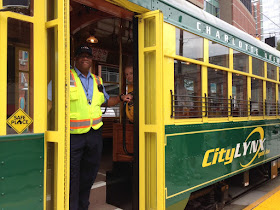 |
| Street view, from Google Maps, of North College at Eighth Street, which tops the city's high-accident list |
This year's list of high-accident intersections in Charlotte is up, and guess what. Once again one-way streets uptown are atop the list.
Here's the Charlotte Observer's article. Notice, in the photo, the pedestrian ambiance (or lack thereof) along North College Street at Eighth Street, the No. 1 high-accident intersection.
My observation this year is the same as two years ago,
when I wrote about this report: One-way streets in and near uptown dominate the list. Is that a reason to switch more to two-way streets?
But
Charlotte Department of Transportation officials disagreed with my thinking. Engineer Debbie Self, in charge of CDOT's traffic and pedestrian safety programs, pointed out in 2013 that of the 150 intersections in uptown Charlotte, the majority involve at least one one-way street and most are not on the high-accident list. About North College Street in particular, in 2013, Self wrote:
"College Street in the areas of 7th, 8th & 9th Streets has been on the HAL [high accident list] for many years. It’s been hard to pin point a single underlying cause. Angle crashes account for about half of the crashes at College and 7th, 8th and 9th. CDOT will likely consider reflective back plates at the signals as a mitigation given our successful reduction in crashes at 5th/Caldwell." [CDOT had attributed the 2013 decline in accidents at Fifth and Caldwell to the installation of the back plates.]
A peek at recent years' high accident lists prompts these questions: Why keep this as a high-speed one-way street through the heart of your downtown? And since its high-accident intersections have comparatively light traffic, what is going on?
Some observations:
I walk along North College a lot, going to and from the UNC Charlotte Center City Building, and the rest of uptown. (At least, I did. Ninth and Eighth streets have been blocked for almost a year from construction of the light rail tracks.) So where are the cars involved in 2014 accidents coming from, especially at Eighth Street? My guess is they're going to and from surface parking lots near the rail line, which have not closed. If you're pulling in or out of a parking lot, you are not driving quickly. So it's likely some accidents are caused by speeding drivers on North College Street mixing with motorists turning into lots or onto Eighth Street.
North College is a major, one-way artery through uptown just one block from, and parallel to, the main uptown street, Tryon Street, where flocks of pedestrians, bus and delivery trucks as well as some timed-to-slow-you traffic lights combine to make speed impossible. But North College comes to us from the street-as-highway school of traffic design. Head north (the only direction you can) from the light at Seventh and you go down a slight hill, encouraging you to speed up. There is no light at Eighth Street, because it is a tiny little street -- actually I love its narrowness, which adds a sense of historical quaintness -- with little traffic. In a car one might just blow past it altogether. I imagine a lot of motorists do just that.
If you're on Ninth Street, it's hard to see what's coming on College. If you're tempted to turn right on red, ignoring the sign banning it, you might well get slammed into by a car zipping up College Street.
 |
| The No.3 high accident intersection is one block north, North College at Ninth Street. (Google Maps) |
Meanwhile, with the opening of the UNC Charlotte building and growing numbers of uptown residents, plus more bars and nightlife, more people are walking even on this rather unpleasant street -- a street decidedly not designed for pedestrians.
Further, this area is only a block from two light rail stops (Seventh Street and the
to-open-in-2017 Ninth Street). The area should be notably more pedestrian friendly. But with back-of-curb sidewalks, a lack of street trees for several blocks and surface parking lots way too prevalent, it isn't.
Solution? CDOT can't alter property lines or force land owners to stop tearing down older buildings and replacing them with surface parking lots or force them to develop the property if they don't want to. So CDOT is left with the standard toolkit for traffic-calming: traffic humps (not bumps, but humps you can glide over at 20 mph but not at 40), stop signs (ugh), traffic circles, more on-street parking. What about a bike lane? No, the cars will not be able to travel as fast. But this is one block off main street in a city of 800,000. Slower is OK.
Or, might I suggest, turning it back into a two-way street?















